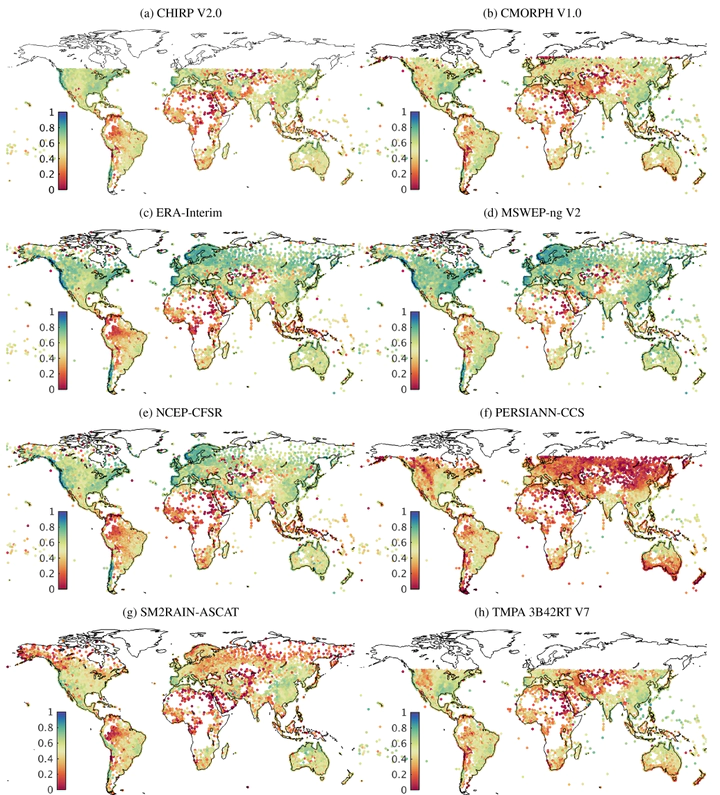Global-scale evaluation of 22 precipitation datasets using gauge observations and hydrological modeling
 Temporal correlations between 3-day mean gauge- and dataset-based P time series
Temporal correlations between 3-day mean gauge- and dataset-based P time seriesAbstract
We undertook a comprehensive evaluation of 22 gridded (quasi-)global (sub-)daily precipitation (P) datasets for the period 2000–2016. Thirteen non-gauge-corrected P datasets were evaluated using daily P gauge observations from 76 086 gauges worldwide. Another nine gauge-corrected datasets were evaluated using hydrological modeling, by calibrating the HBV conceptual model against streamflow records for each of 9053 small to medium-sized ( < 50 000 km2) catchments worldwide, and comparing the resulting performance. Marked differences in spatio-temporal patterns and accuracy were found among the datasets. Among the uncorrected P datasets, the satellite- and reanalysis-based MSWEP-ng V1.2 and V2.0 datasets generally showed the best temporal correlations with the gauge observations, followed by the reanalyses (ERA-Interim, JRA-55, and NCEP-CFSR) and the satellite- and reanalysis-based CHIRP V2.0 dataset, the estimates based primarily on passive microwave remote sensing of rainfall (CMORPH V1.0, GSMaP V5/6, and TMPA 3B42RT V7) or near-surface soil moisture (SM2RAIN-ASCAT), and finally, estimates based primarily on thermal infrared imagery (GridSat V1.0, PERSIANN, and PERSIANN-CCS). Two of the three reanalyses (ERA-Interim and JRA-55) unexpectedly obtained lower trend errors than the satellite datasets. Among the corrected P datasets, the ones directly incorporating daily gauge data (CPC Unified, and MSWEP V1.2 and V2.0) generally provided the best calibration scores, although the good performance of the fully gauge-based CPC Unified is unlikely to translate to sparsely or ungauged regions. Next best results were obtained with P estimates directly incorporating temporally coarser gauge data (CHIRPS V2.0, GPCP-1DD V1.2, TMPA 3B42 V7, and WFDEI-CRU), which in turn outperformed the one indirectly incorporating gauge data through another multi-source dataset (PERSIANN-CDR V1R1). Our results highlight large differences in estimation accuracy, and hence the importance of P dataset selection in both research and operational applications. The good performance of MSWEP emphasizes that careful data merging can exploit the complementary strengths of gauge-, satellite-, and reanalysis-based P estimates.